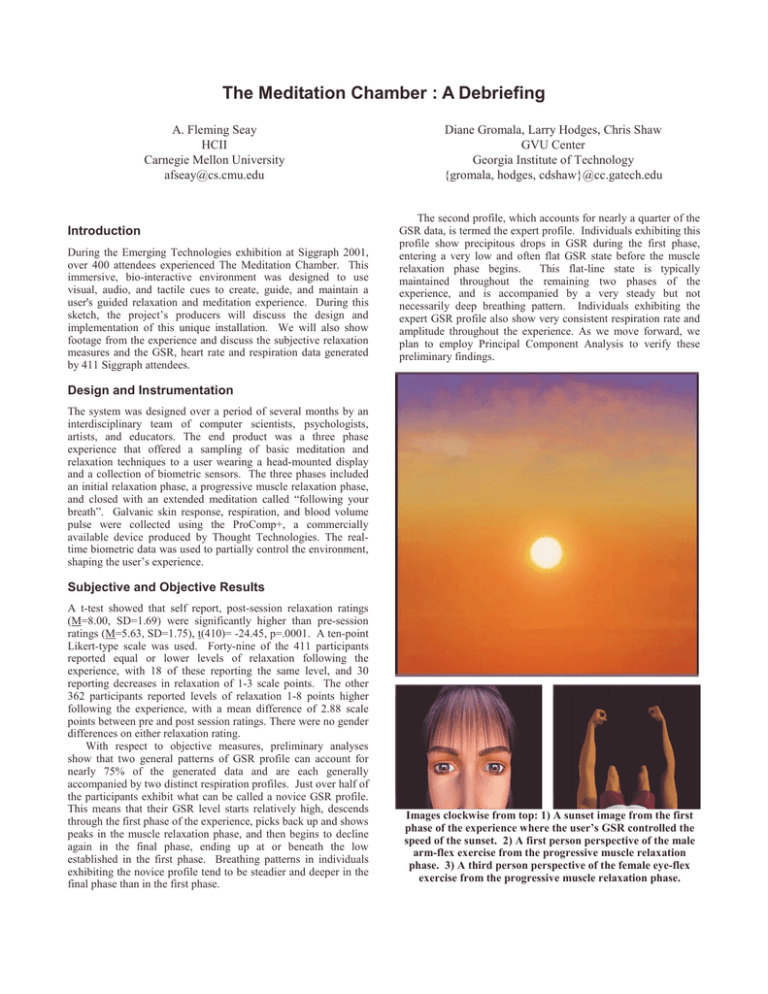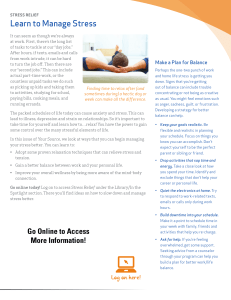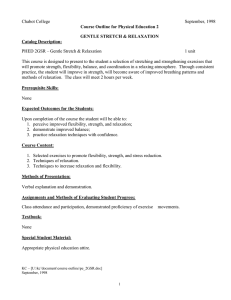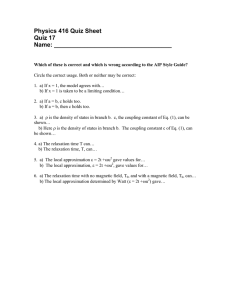The Meditation Chamber : A Debriefing
advertisement

The Meditation Chamber : A Debriefing
A. Fleming Seay
HCII
Carnegie Mellon University
afseay@cs.cmu.edu
Introduction
During the Emerging Technologies exhibition at Siggraph 2001,
over 400 attendees experienced The Meditation Chamber. This
immersive, bio-interactive environment was designed to use
visual, audio, and tactile cues to create, guide, and maintain a
user's guided relaxation and meditation experience. During this
sketch, the project’s producers will discuss the design and
implementation of this unique installation. We will also show
footage from the experience and discuss the subjective relaxation
measures and the GSR, heart rate and respiration data generated
by 411 Siggraph attendees.
Diane Gromala, Larry Hodges, Chris Shaw
GVU Center
Georgia Institute of Technology
{gromala, hodges, cdshaw}@cc.gatech.edu
The second profile, which accounts for nearly a quarter of the
GSR data, is termed the expert profile. Individuals exhibiting this
profile show precipitous drops in GSR during the first phase,
entering a very low and often flat GSR state before the muscle
relaxation phase begins.
This flat-line state is typically
maintained throughout the remaining two phases of the
experience, and is accompanied by a very steady but not
necessarily deep breathing pattern. Individuals exhibiting the
expert GSR profile also show very consistent respiration rate and
amplitude throughout the experience. As we move forward, we
plan to employ Principal Component Analysis to verify these
preliminary findings.
Design and Instrumentation
The system was designed over a period of several months by an
interdisciplinary team of computer scientists, psychologists,
artists, and educators. The end product was a three phase
experience that offered a sampling of basic meditation and
relaxation techniques to a user wearing a head-mounted display
and a collection of biometric sensors. The three phases included
an initial relaxation phase, a progressive muscle relaxation phase,
and closed with an extended meditation called “following your
breath”. Galvanic skin response, respiration, and blood volume
pulse were collected using the ProComp+, a commercially
available device produced by Thought Technologies. The realtime biometric data was used to partially control the environment,
shaping the user’s experience.
Subjective and Objective Results
A t-test showed that self report, post-session relaxation ratings
(M=8.00, SD=1.69) were significantly higher than pre-session
ratings (M=5.63, SD=1.75), t(410)= -24.45, p=.0001. A ten-point
Likert-type scale was used. Forty-nine of the 411 participants
reported equal or lower levels of relaxation following the
experience, with 18 of these reporting the same level, and 30
reporting decreases in relaxation of 1-3 scale points. The other
362 participants reported levels of relaxation 1-8 points higher
following the experience, with a mean difference of 2.88 scale
points between pre and post session ratings. There were no gender
differences on either relaxation rating.
With respect to objective measures, preliminary analyses
show that two general patterns of GSR profile can account for
nearly 75% of the generated data and are each generally
accompanied by two distinct respiration profiles. Just over half of
the participants exhibit what can be called a novice GSR profile.
This means that their GSR level starts relatively high, descends
through the first phase of the experience, picks back up and shows
peaks in the muscle relaxation phase, and then begins to decline
again in the final phase, ending up at or beneath the low
established in the first phase. Breathing patterns in individuals
exhibiting the novice profile tend to be steadier and deeper in the
final phase than in the first phase.
Images clockwise from top: 1) A sunset image from the first
phase of the experience where the user’s GSR controlled the
speed of the sunset. 2) A first person perspective of the male
arm-flex exercise from the progressive muscle relaxation
phase. 3) A third person perspective of the female eye-flex
exercise from the progressive muscle relaxation phase.





